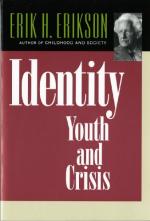
|
| Name: _________________________ | Period: ___________________ |
This test consists of 15 multiple choice questions and 5 short answer questions.
Multiple Choice Questions
1. What does it mean when the author states, "to review the concept of identity"?
(a) Give a lecture.
(b) Sketch its history.
(c) Write an outline.
(d) Disprove identity.
2. As discussed by Erikson in Chapter 2, what occurs when a system either biological or social malfunctions?
(a) Confusion.
(b) Pathology.
(c) Identity loss.
(d) Restart of identity formation.
3. According to Freud, what is the third stage of development called?
(a) Oral stage.
(b) Anal stage.
(c) Latent stage.
(d) The phallic stage.
4. What does Erikson state that childhood and youth predispose men to?
(a) Childlike wonder.
(b) Totalitarianism.
(c) Confused identities.
(d) Structure.
5. During Erikson's final stage of development, individuals having a sense of Generativity may engage in what type of activities?
(a) Finding a new job.
(b) Leading future generations to succeed.
(c) Planing for the future.
(d) Listlessness.
6. What does Erikson suggest society's child training systems does for the uniqueness of society?
(a) Provide meaning.
(b) Strengthen it.
(c) Preserve it.
(d) Increase standard of living.
7. In developing Erikson' theory of group identity, what two processes must the ego consist of that assist in defining both body in community membership?
(a) Biological and social.
(b) Social and mental.
(c) Spiritual and social.
(d) Spiritual and biological.
8. What does Erikson state are not constantly bolstered, an idea that is contrary to popular belief?
(a) Weak egos.
(b) The arrogant.
(c) Strong egos.
(d) Self conscious.
9. During the final stages of Erikson's stages of identity development, what type of feelings may individual experiencing stagnation feel?
(a) Hope for the future.
(b) Calmness.
(c) Reflection.
(d) Despair and hopelessness.
10. What does Erikson suggest wholeness of the individual is associated with?
(a) The earth.
(b) Equilibrium and health.
(c) Totalitarianism.
(d) Positive psychology.
11. What does the success of identification during Erikson's stages of development depend on?
(a) Parental support.
(b) It is society specific.
(c) Nothing.
(d) Interacting with trustworthy models.
12. During the process of Erikson's stages of identity development, what will depend on the total process of identity development?
(a) Biology.
(b) Psychosocial strength.
(c) Self.
(d) Environment.
13. According to Erikson, in his review and observations of changes in culture, what does he suggest will become common values among today's youth?
(a) Common identity.
(b) Leadership.
(c) Dissonance.
(d) Choice and identity.
14. According to Erikson in Chapter 2, what occurs when the ego combines elements that result in an inability to form a positive self-image?
(a) Stereotyping.
(b) Negative identity formation.
(c) No identity formation.
(d) Ego synthesis fails.
15. What aspects of Freud's theory of development does a functional ego integrate?
(a) Social and environmental.
(b) Psychosocial and biological.
(c) Psychosocial and psychosexual.
(d) Biological and psychosexual.
Short Answer Questions
1. According to Freud, what is the second stage of identity development called?
2. In Chapter 2, what does Erikson feel about how psychologists treat social dynamics and external social elements?
3. What was William James obsessed with his entire life?
4. Because of an individual's tendency to define self based on history, what does Erikson think this self-based history leave little room for the individual to create?
5. What does Erikson state is the first age of identity development involve in terms of conflict?
|
This section contains 515 words (approx. 2 pages at 300 words per page) |

|




